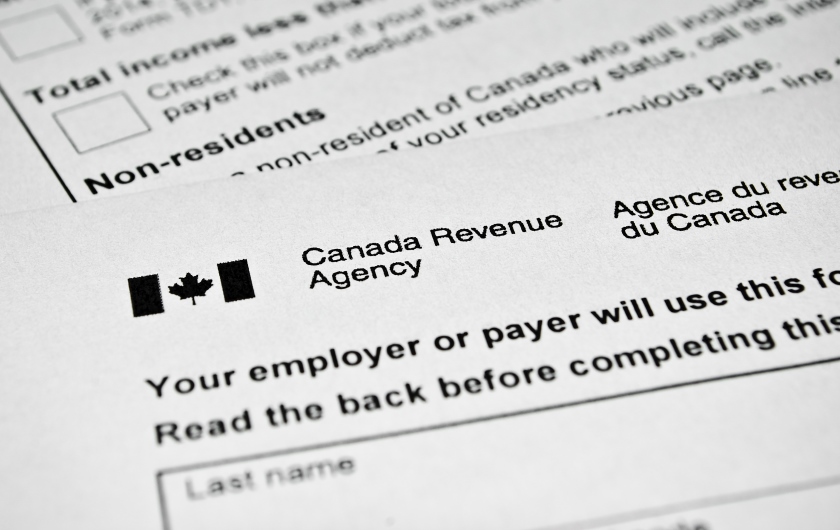For anyone planning to claim the “Canada caregiver amount” at tax time, it’s not too soon to start getting things in order
By Olev Edur
Photo: iStock/gradyreese.
The great news for all of us generally is that we’re living longer than ever before. The not-so-good news is that those extra years probably won’t be entirely trouble-free. According to a 2018 Statistics Canada study, while we are indeed living longer, we’re also spending more time in less than ideal health. In many cases, this translates into pressure on other family members to provide for our necessary care and upkeep.
Many other studies and reports in recent years have attested to the growing stress endured by those who provide care to increasingly fragile spouses or parents; the so-called sandwich generation—Canadians now in their 40s, 50s, or 60s who find themselves becoming caregivers for their aging parents while raising their own families at the same time—are particularly in the crosshairs.
Anyone trying to care for a low-income dependant with an impairment in physical or mental function will know that the sacrifices in time and money can be substantial. While the Canada Revenue Agency (CRA) can’t do much about the time issue, the tax agency will help you defray the costs through a number of interrelated tax credits and deductions that are centred around the newly named and recently revised “Canada caregiver amount.”
Making a caregiver claim involves a number of steps, so while your 2019 tax return won’t be due for several months, if you’re facing a caregiver situation, you should start now to sort out what you can claim and what you’ll need for supporting documentation.
First, if it hasn’t already been done, you’ll need to get CRA-acceptable proof of the dependant’s health condition.
“You can claim the caregiver credit only if the dependant is impaired physically or mentally,” says Tannis Dawson, the vice-president of high net worth planning at TD Wealth in Winnipeg. “To support the claim, you may need a signed letter from a doctor describing the condition, although a completed Form T2201 [Disability Tax Credit Certificate] approved by the CRA would also do. But the letter from the doctor is easier to get than the disability certificate.”
Dawson adds that while spouses, parents, or children are typically the dependants when it comes to caregiver claims, the credit can be applied even when the dependant is an infirm grandchild, aunt, uncle, nephew, or niece. You may be able to claim the credit more than once if you have multiple qualifying dependants. And your own income level doesn’t matter. “These are non-refundable credits based on the lowest marginal tax rate, so they aren’t affected by your income,” she says.
Nevertheless, the income of the dependant or dependants will affect the equation, so you’ll need to ascertain the income they receive, and it may come from multiple sources, complicating the process. When it comes to aging parents, for example, their income sources could include Canada Pension Plan (CPP) and Old Age Security (OAS) benefits, pension income, and investment earnings. Therefore, you’ll have to familiarize yourself with the dependant’s tax return, too.
Several Places for Claims
When it comes to your own tax return, the process of making a caregiver claim varies a bit, depending on who the dependant is.
If it’s your spouse, then you can claim the caregiver amount of up to $6,986 on line 304, plus you can add $2,182 to the basic $11,809 spouse or common-law partner amount you can claim for a dependent low-income spouse on line 303 (for a total $13,991).
Note that the tax return stipulates amounts for the various non-refundable credit calculations on Schedules 1 and 5. These initial amounts are subsequently multiplied by a percentage reflecting the lowest federal tax rate to arrive at a credit total that is deductible from your federal tax bill; provinces and territories have their own credit rates, as well, so the total credit will in most cases be equivalent to the amounts multiplied by your lowest combined federal-provincial tax rate. Note, too, that the dollar figures provided here are for the 2018 taxation year: figures for the 2019 taxation year weren’t available at press time and will be slightly higher due to annual inflation-related adjustments.
If you make no claim for a spousal amount on line 303, you may be able to make a claim of $2,182 on line 305 for one dependent and infirm family member aged 18 or older (including a parent or grandparent) whom you supported and who lived with you at some time during the year. You can then also claim the caregiver amount of $6,986 on line 304.
In either of these cases, you must first enter the relevant figures on Schedule 5 (Amounts for Spouse or Common-Law Partner and Dependants) and deduct the dependant’s net income (line 236 of the tax return) from the increased amount on either line 303 or 305, as well as from the base amount of $23,391 in the calculations for line 304.
In the case of other infirm dependants aged 18-plus not claimed on line 303 or 305—and this can include aunts, uncles, nieces, and nephews—you can claim the caregiver amount of $6,986 on line 307 (again using Schedule 5) but cannot claim a basic amount of $11,809 or the increase of $2,182 for these dependants. These dependants don’t necessarily have to be living with you in order for you to make a claim, though you must be a primary caregiver. You’ll have to do the credit calculations separately for each dependant you are claiming.
And finally, in the case of disabled children under age 18 who are eligible for treatment, you can claim $2,182 on line 305 plus $2,182 on line 367; if ineligible for line 305, you may still be able to claim $2,182 per qualifying person on line 367.
So assuming you’re required to be a caregiver to a dependent and infirm spouse or parent, and that dependant received only OAS and a bit of CPP income, you could be entitled to an extra $9,168 in caregiver-related amounts. Using a 25 per cent combined federal-provincial tax credit rate, this would translate into an extra $2,292 in your pocket. And that’s not all to which you might be entitled.
Transferring Unused Credits From Dependants
As a caregiver to a dependent and infirm family member, you’re allowed in some instances to claim tax credits that could not be used by the dependant to reduce his or her taxes to zero—that is, the person doesn’t have enough income to offset all the credits. One of the most significant of these transferrable credits, applicable for those with severe health issues, is the disability tax credit (DTC).
To qualify for the DTC, a person must have one or more severe and prolonged (lasting at least 12 months) impairment(s) in physical or mental function, the effects of which are to “markedly restrict” his or her ability to perform one or more basic activities of daily living (such as eating, bathing, and walking). The condition must be detailed in Form T2201 (Disability Tax Credit Certificate), which must be approved by CRA.
If the dependant is your spouse, you can claim up to $8,235 in unused DTC amounts (and possibly certain other unused credit amounts such as the age credit of $7,333) after completing the necessary sections of Schedule 2; the total of these transferred credit amounts is then entered on line 326 of Schedule 1 on your return.
For you to claim the unused disability tax credits of an infirm person other than your spouse who is 18 or older, the person must be “dependent on you on a regular and consistent basis for all or some of the basic necessities of life (such as food, shelter, and clothing),” according to CRA’s Income Tax Folio S1-F1-C2, Disability Tax Credit. If the certificate is approved, you can complete the appropriate section of the worksheet for Schedule 1, then enter the result on line 318 of Schedule 1.
The other potentially significant credit that can be transferred from a dependant to a qualifying caregiver is the medical expense tax credit. This credit covers a wide variety of expenses, including payments to a medical doctor, dentist, nurse, and certain other medical professionals, as well as to a public or licensed private hospital, payments for prescription drugs, artificial limbs, wheelchairs, crutches, hearing aids, prescription eyeglasse and contact lenses, dentures, pacemakers, and certain prescription medical devices—even premiums you paid to private health service plans. For more information on what can be claimed, refer to CRA’s Income Tax Folio S1-F1-C2, Disability Tax Credit or Guide RC4065, Medical Expenses.
There’s no limit to the medical expenses that a person can claim (the claim can be for any 12-month period ending in the current year, as opposed to the calendar year), and they don’t have to be expended in Canada to be eligible. There is, however, a deductible: you must exclude from your total expense claim the lesser of three per cent of your net income or $2,302.
When it comes to your immediate family, you can freely claim all medical expenses paid for yourself, as well as your spouse and children under 18 on line 330 of Schedule 1 of your own or your spouse’s tax return. As with most other non-refundable credits, there are federal amounts as well as provincial/territorial amounts, the latter being claimable on line 5868 of your provincial or territorial Form 428.
When it comes to claiming unused medical expense tax credits from the tax returns of other dependants, you must first of all be the primary caregiver of the dependant, who must be financially dependent on you due to age or disability. The eligibility list includes children and grandchildren 19 or older, as well as parents, grandparents, brothers, sisters, aunts, uncles, nieces, and nephews. If there’s more than one such dependant, you have to do separate deductible calculations for each dependant, enter the results on line 331 of Schedule 1, and then claim the provincial/territorial credit on line 5872 of your provincial or territorial Form 428.
Some Additional Tax Considerations
As you can see, a combination of your caregiver credits along with unused credits transferred from the returns of qualifying dependants can result in a sizable reduction in your tax bill. If significant medical expenses as well as the disability tax credit are involved and your dependant has little or no income, the total amount could well exceed $20,000, meaning that your tax bill at a 25 per cent marginal tax rate could result in total credits of $5,000 or more in any given year.
Furthermore, since taxpayers are allowed to file amendments to their tax returns going back up to 10 years, if your dependant or dependants haven’t been claiming the various health-related credits in the past (perhaps because they wrongly thought they couldn’t be used because their own income was too low), you may be able to arrange to claim these unclaimed credits on your own past returns.
“You can go back 10 years on the disability tax credit, medical expenses—anything that you want to amend,” TD Wealth’s Tannis Dawson says. “If you write a letter to the CRA, say your father or whoever is impaired, and ask them to please adjust his returns, they’ll go back and adjust them all. Their computer program will automatically do all the calculations.”
Because the health and disability-related provisions of the Income Tax Act are so complex, an entire industry of consultants has evolved to service those who feel they have been shortchanged on their tax credits, often at a cost of thousands of dollars.
“We don’t need these companies out there,” Dawson says. “It’s sad. People don’t know if they qualify for the disability tax credit, but you just need to go to a doctor and get the T2201 approved, then go to an accountant who can go back a maximum of 10 years and make the necessary adjustments.
“If you are helping either in the home or by paying for stuff, you may be able to claim the caregiver credit, and you may be able to use the unused portions of the dependant’s disability tax credit or medical expenses,” Dawson adds. “But you do need to be careful because the eligibility rules can differ. Special rules may apply, for example, with the disability tax credit, which has some restrictions on what you can claim.”
The bottom line is that if you are helping in any way to care for a loved one who is infirm, you may be entitled to substantial tax credits. Getting that doctor’s letter or form T2201 is an essential first step in setting up your claims; beyond that, there should be no need to seek the services of a consultant to secure your entitlements. Any certified accountant should be able to do it for you if you find the going too complicated to do yourself.





